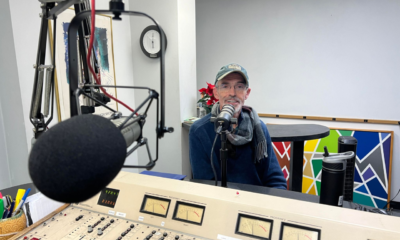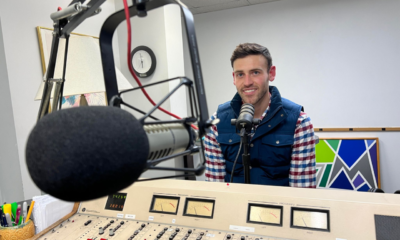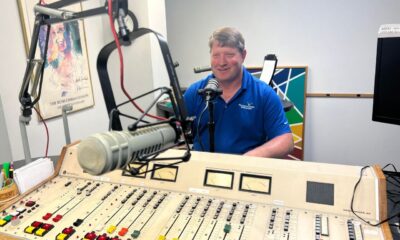Minnesota
Minnesota prison program prepares inmates for solar jobs

ST. PAUL, Minn. (AP) — A growing demand for clean energy employees led the Minnesota Department of Corrections earlier this year to offer a solar installation course to two classes of inmates prior to their release dates.
Held last spring and summer, 30 men took the 48-hour solar installer training course from instructors working with the Wisconsin-based Midwest Renewable Energy Association. The nonprofit used the same course it offers members of the general public.
While it’s still too soon to tell if the program will succeed in helping inmates find work, its existence is a reflection of Minnesota’s changing energy economy.
—
The nonprofit news outlet Energy News Network provided this article to The Associated Press through a collaboration with Institute for Nonprofit News.
—
When Ruth Stadheim, director of career and technical education for the Corrections Department, saw a few years ago that the state would be requiring utilities to produce 1.5 percent of their electricity from solar by 2020, she figured the market for workers would likely explode.
“It’s a field we know they could get a job in,” she said. “We heard the industry would hire everyone we trained.”
The Solar Foundation confirms that impression, reporting that Minnesota saw 94 percent job growth in installation work from 2016 to 2017, one of highest increases of any state in the country. Solar also seemed to fit other training the prison system offers in construction trades and manufacturing, among other professions, Stadheim said.
While the solar training initiative in Minnesota looks promising, it suffers from the same woes as many career training programs: Data does not exist on whether the inmates, after their release, found jobs. And the national solar installer test turned out to be challenging — half the men in the program failed to pass it, some by just a few points.
Still, Corrections Department officials believe the solar industry is a promising bright spot for former inmates. They plan to increase the number of solar courses next year to reach as many as 75 participants. Adding tweaks to the process, they hope, will increase the pass rate.
Preparing inmates for employment is a priority of many states because it helps reduce recidivism, a particularly tough problem in Minnesota, which has one of the highest rates in the country. Solar could be a small part of an answer to the problem of finding employment for the formerly incarcerated, Stadheim said.
“Getting a job is really important. It’s probably the number one factor,” she said. “We want them to find a stable living environment but you can’t have a stable living environment if you can’t afford it. And you can’t afford it if you don’t have a job.”
Minnesota is among a handful of corrections departments to have trained inmates for solar industry jobs. A federal prison in Elkton, Ohio, offered solar training to inmates in 2012, as did the Corrections Department in Colorado a year earlier. Georgia’s prison system came under criticism a few years ago for a contract with solar manufacturer Suniva, which employed inmates.
The solar installer program was held at Willow River boot camp, a small facility 100 miles north of the Twin Cities that holds non-violent prisoners who qualify for early release. About 160 inmates are housed there, most serving time for drug- and alcohol-related offenses. The highly regimented boot camp begins with prisoners rising at 5 a.m., followed by work, exercise, classes and other activities, Stadheim said.
A federal grant paid for the solar training program, which was accredited by a local college. All inmates in career training in correctional facilities, including those in the solar installation program, are required to take a human resources course to help them understand how to work with colleagues and supervisors, she said.
Two classes of 15 students each were taught in May and August. They were timed so that graduates could conceivably get solar jobs in the busy seasons of summer and fall, Stadheim said. The first class saw 40 percent of students pass the PV Associate Exam administered by the North American Board of Certified Energy Practitioners. Students complained of having little time to study for the rigorous exam. Two-thirds of students in the second class passed in part because prison officials gave them more study time, Stadheim said.
“You have to make sure these guys are studying for the test; it’s not enough for them to just take the classes,” said Kris Schmid, a solar installer in Luck, Wisconsin, who taught the first course. “You need for them to put in the time, so they can understand the concepts.”
The prison environment presents a series of obstacles different from a typical classroom. With no internet access allowed, Schmid was unable to connect to websites related to solar installation. The “engagement” was less than a typical class environment and many students struggled with reading and math, he said.
“I would say over 50 percent were really interested and engaged and saw this as a path for their future and the other 50 percent I wasn’t as sure of — it wasn’t as obvious to me,” Schmid said.
Another potential problem with some ex-inmates is a lack of mobility. Under the terms of their probation, they have limitations on where they can work and travel. Though Schmid thought three or four students were good enough to work for his company, Legacy Solar, probation rules would likely make employment in another state difficult, if not impossible.
Stadheim said ex-inmates can move from their assigned counties to one where they have found a job. Moving to Wisconsin for work, however, is not an option.
Julie Brazeau, the Midwest Renewable Energy Association’s solar technical assistance coordinator, said the struggle inmates had with passing the test is not unusual considering many come from socially and economically disadvantaged backgrounds. The association teaches the solar classes to adults, some who are ex-convicts, in low-income neighborhoods in Chicago.
“In Chicago we’re not seeing as much success either,” she said. “We’re struggling, and we’re trying to get the scores up.”
A 70 percent pass rate among those taking the certification test would be considered successful for programs teaching those challenging populations, Brazeau said, adding: “In my opinion, the best measure of success for this population would be a job.”
The main stumbling block for students in Chicago, like Minnesota, is math.
“Many of them are dogged by the math — there is some math involved,” Brazeau said. “It’s not rocket science but it’s tough. We try to get them through it.”
The association, which developed the solar installation course five years ago, normally charges students $1,800 for the classes; inmates receive the same training for free. More than 90 percent of students who take the installer course pass the certification test.
“Our regular audience is self-selecting, and they have skin in the game, and that helps,” she said.
A handful of men who took the course and failed the certification test have contacted prison officials and trainers to ask if they could have a short refresher course and then take the test again. Brazeau and Stadheim are working on scheduling an additional meeting and pointed some of them to online instructional resources.
“We want to give them the best chance we can of passing the second time around,” Brazeau said.
The Corrections Department does not know how many of the 30 men in the solar program were hired because it did not track post-release employment for any of its training, Stadheim said.
This is partly by design because department policy did not allow former inmates or prison officials to have contact with the department or trainers directly.
“We don’t know who is employed and who isn’t, and part of the problem is they are from all over the state,” she said. “But now the policy has changed and if we have a business purpose we can contact them.”
The new policy allowed the department to begin a partnership with other state agencies to hire four employment “navigators” to work with the Corrections Department on placing ex-inmates in jobs and tracking their progress, Stadheim said.
She is relieved to have the help.
“I’ve been going out every month talking to large employers and breaking down the felon-phobia,” Stadheim said. “Now employers are calling me a lot. I don’t have the capability of doing everything. They’ll be doing that now.”
By FRANK JOSSI of Energy News Network







